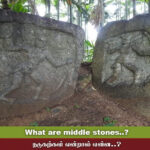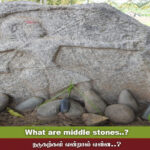

What are middle stones..?

Man has worshiped nature and feared death since the beginning of time when he lived in forests. The question of where a person who dies like that will go to his mind kept bothering him. He also used to make memorials for the dead, one of them being stone blocks. These are more than three thousand years old. Hunting scenes and figures of man and animals are found in many places within this rock. These rock paintings may be the forerunners of mesothelioma.. Although there are mentions of mesothelioma in Sangam literature, they are no longer with us. Destroyed by the flood of time. Paintings made for heroes who died in battle with animals are ancient. Even though memorial stones have been taken all over the world for the dead since the Paleolithic era, it has been a special thing to take a center stone called Veerakkal for those who died in war. Even animals and chickens have the habit of taking center stones. During the period of Pallavars, Panars and Gangars, a lot of nadustones have been taken for those who died in Anirai War.
Types of gemstones:
We can classify them into some categories based on their structure, shapes, and tools.
- Memorial stones
- Veerakkal
- New continent
- Arikandam
- The plot
- Pulikuthupatthan stone
- The stone was pierced by an elephant
- The wild boar stung the stone
- Chicken stones
- Climbing rock
can be classified as
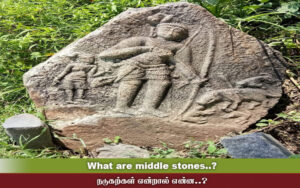 Monuments
Monuments
The primordial man planted stones at the site to mark the burial place of his group’s dead. It was transformed in different ways in different parts of the world in different ways like Kudkukals, Kapadugai, Kalvattam, Garkuvai, Karthitta etc. Gravestones were taken for those who died in battle, and hunting. Even today, memorial stones for the dead can be found in Ayyanar, Chelliyamman and Karupiya temples in villages. Women who died in childbirth are shown with their infants. Even today this practice is in vogue.
Veerakal
We can call the center stones taken for those who died in the war heroically. From the Pallavar period to the Nayak period, such heroic stones are found all over Tamil Nadu.
Navkandam
When a war is going on between two countries, a person who sacrifices his life for the victory of his country is called Navakandam. Navakandam is the ritual of eating eight parts of one’s body and sacrificing one’s own head to the one who eats it. To symbolize such sculptures, the sword in the warrior’s hand is shown in the middle of the warrior’s neck. In this way, the new land was given so that the sick king could recover and the long-standing festival could take place. There are 5 Navakanda sculptures like this in Aarakaur, Salem district.
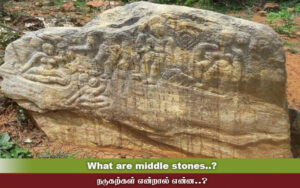 Arikandam
Arikandam
There are some differences between Navakanda and Arikanda. In the Ari continent, they cut off their heads in one cut. Similar carvings are found all over Tamil Nadu showing her holding her own hair.
This is a case of self-sacrifice. In the early period they did this voluntarily, but later they were forced to sacrifice. Inscriptions state that Uthirapatti land was gifted to them. There is a similar Uthirapatti inscription at Orakaur
Satikal
Sati stones were erected for women who were buried with their wives after the death of their husbands in war or other causes, or after a few weeks of rituals were carried out and put into the fire. They are worshiped by his dynasty under the name of Deepanjai. There are many Deepanjai temples in Tamil Nadu. There is a small temple of Deepanjai at Ayyanar temple in Aarakaur. Coercion, which was done willingly in the early period, was forced later. In independent India, coercion was banned by the Constitution at the initiative of Raja Ram Mohan Roy.
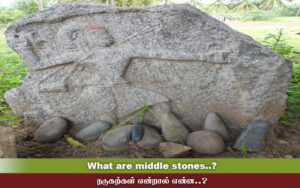 The tiger was stoned
The tiger was stoned
When man lived in villages next to forests, tigers used to attack and kill him and his livestock. A young man living in such villages would have gone on a tiger hunt and killed the tiger himself and died a heroic death. Tiger Kuthi Nadugall is the center stone that commemorates the bravery of that young man. The Salem Museum has two tiger cubit stones brought from Senta Mangalam. All over Tamil Nadu there are similar tiger stone stones. There is a street in Salem Cave called Pulikutty Street. The elephant bit the stone The custom of using elephants in war started from the beginning of the historical period among the Tamil kings. Wild elephants were captured and trained for war and used in war. In the villages near the forests, wild elephants destroyed the crops and killed the animals that were raised by the man. In this way, Yanankuthipattaan stone is the tombstone placed for soldiers who died in war or during elephant hunting.
The wild boar was stung by a stone
The middle stone is the wild boar stab stone, which is kept for a hero who himself died after hunting the wild boars that destroyed the crops in the agricultural lands. There is such a middle stone in the Kalvarayan tradition of the Salem Historical Research Center, which we will see, detailed information about it in the following chapters.
Chicken stones
Not only for humans, but also for dogs and chickens that humans raise.
Thiru Villupuram Veeraragavan Ayya, guru of Nam Salem Historical Research Institute, has discovered a stone inscription for chicken in the town of Arasalapuram.
A middle stone for chicken has also been found in a town called Indore. Achirubakkam Thamaraikannan Ayya has discovered this. This center stone may have been taken for a chicken that died in a chicken market
Climbing Veerakal
Climbing is one of the traditional sports of Tamils. This climbing stone found in Karamanthurai is now in the Salem Museum.

